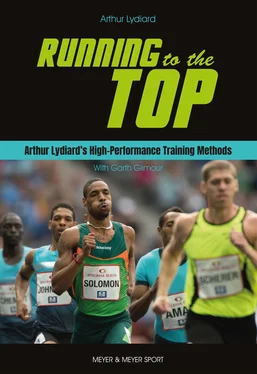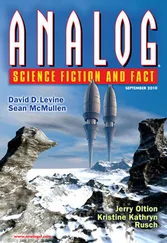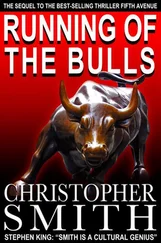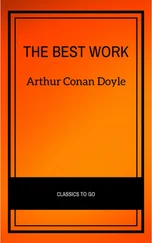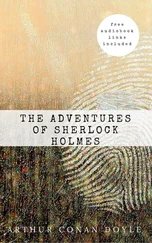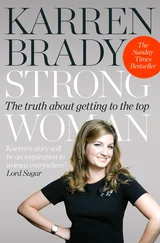The contents of this book were carefully researched. However, readers should always consult a qualified medical specialist for individual advice before adopting any new nutrition or exercise plan. This book should not be used as an alternative to seeking specialist advice.
All information is supplied without liability. Neither the authors nor the publisher will be liable for possible disadvantages, injuries, or damages.
Arthur Lydiard
Arthur Lydiard’s High-Performance Training Methods
With Garth Glimour

British Library Cataloguing in Publication Data
A catalogue record for this book is available from the British Library
Running to the Top
Maidenhead: Meyer & Meyer Sport (UK) Ltd., 2021
9781782558552
All rights reserved, especially the right to copy and distribute, including the translation rights. No part of this work may be reproduced—including by photocopy, microfilm or any other means—processed, stored electronically, copied or distributed in any form whatsoever without the written permission of the publisher.
© 1997 by Meyer & Meyer Sport (UK) Ltd.
3rd Edition 2011
1st reprint 2013
4th Edition 2021
Aachen, Auckland, Beirut, Budapest, Cairo, Cape Town, Dubai, Hägendorf, Indianapolis, Maidenhead, Singapore, Sydney, Tehran, Vienna
Credits
| Cover design: |
Katerina Georgieva |
| Cover photo: |
© dpa |
| Interior photos: |
© AdobeStock |
| Interior design & layout: |
Annika Naas |
| Managing editor: |
Elizabeth Evans |
 |
Member of the World Sport Publishers‘ Association (WSPA) www.w-s-p-a.org |
9781782558552
E-Mail: info@m-m-sports.com
www.thesportspublisher.com
Introduction
Chapter 1:The 21 Factors
Chapter 2:Why Is Running Valuable?
Chapter 3:The Basics of Youth
Chapter 4:Developing Fitness
Chapter 5:How to Start Running
Chapter 6:Running Technique
Chapter 7:The Path to Full Potential
Chapter 8:Setting a Schedule
Chapter 9:Injuries
Chapter 10:Altitude
Chapter 11:Myths and Misconceptions
Chapter 12:Setting Out Your Schedule
Chapter 13:Marathon
Chapter 14:The Athlete and the Coach – The Vital Relationship
Chapter 15:Food, Fats, Vitamins and Minerals
Chapter 16:Team Training
Chapter 17:Evaluating Your Training
Chapter 18:Training Terms
Chapter 19:Shoes and Feet
Chapter 20:Foods and Fats
Chapter 21:The Value of Good Preparation
Chapter 22:Warming Up and Cooling Down – Two Musts
Index

Running is defined as either the act of progressing by advancing each foot alternately, never having both on the ground at once, or the act of proceeding by lifting one foot before the other is down. Neither definition is particularly complicated and neither places any limitation on the degree of forward momentum attained.
The art and technique of running and the processes of talking and writing about running should be equally as simple. Running, after all, is as natural as walking. Once a child has learnt to walk, no one has to teach it how to run.
This book, then, is written to be as uncomplicated as the principle of putting one foot in front of the other without ever having both on the ground at once. Its purpose is simple – to enable you go faster, and get both feet off the ground if you want to, or farther, or both faster and farther, according to your personal aims and aspirations. If you want to be an Olympic or world champion, this book is for you. If you merely want to jog in comfort around your neighbourhood in the interests of your physical well-being, this book is for you, too.
We set out the guidelines, the rationale, the simple principles behind the art and pleasure of running better; we offer schedules upon which to base your own programmes of training for whatever you aspire to. The rest is up to you.
Arthur Lydiard’s philosophy of running training is like none other, applicable to anyone who pulls on a pair of running shoes. He devised the principles of training now employed by leading coaches and athletes all around the world, in track and field and in many other sporting spheres; he invented the pure and simple exercise of jogging which has infected millions with its benign bug.
First tested and found successful in the 1950s, the Lydiard system has undergone some subtle refinements through the years. But it remains the same elemental theory that first placed a small handful of ordinary runners, from Lydiard’s immediate neighbourhood in an Auckland, New Zealand, suburb, at the forefront of world middle and distance running for more than a decade. Then, as Lydiard advanced from being a coach of runners to an international coach of coaches, it spread around the running tracks and training centres of the entire world.
Arthur Lydiard turned a simple, practical faith in himself into a world-wide nostrum for everyone seeking a method of running better. His name and his methods have won instant recognition in many nations. As gurus go in the modern world, he ranks among the greatest and, almost certainly, the most physically and psychologically effective.
For several years from the mid-seventies, the late great Japanese middle and distance coach Kiyoshi Nakamura brought teams of his top runners to New Zealand to spend months training in the remote vastness of the South Island back country behind Ashburton. These were the famous runners who, in a sudden spasm reminiscent of the explosion of the Arthur Lydiard-trained team into international running in the sixties, became a dominant world force particularly over the longer distances. The stars were the Soh brothers, then Toshihiko Seko, the legend who won three consecutive Fukuoka marathons, ran world track records for 25,000 and 30,000 metres in New Zealand and took the 1981 Boston marathon in 2:09.26.
Nakamura, one of the most respected figures in Japanese athletics, had an association with New Zealand that stretched back to 1936, when he represented Japan in the historic 1,500 metres which saw Jack Lovelock race away with a spectacular record-making gold medal.
But why, year after year, did he bring his teams of distance runners to New Zealand?
The first reason, he told New Zealand Runner magazine’s Tim Chamberlain in 1982, on his seventh visit, was that Arthur Lydiard lived in New Zealand.
Nakamura was one of the first Japanese runners to learn Lydiard’s methods, the first to invite Lydiard to Japan in 1962. He read all Lydiard’s books and came to believe he knew more about Lydiard’s methods than Lydiard himself because his studies made a vital link between Lydiard techniques, Christianity and Zen. That might be argued. What could not be argued was that Nakamura used Lydiard as the basis for his coaching methods and philosophy that fired Japan, for a time, into the forefront of international middle and distance running. He took his runners to nearly 20 Japanese records, several world records and a string of international successes. Among the Japanese, Nakamura knew Lydiard best. When he died, the vital spark that lit Japan died with him but he had made the point: The Lydiard system, once understood, was the critical factor between success and failure. Olympic marathoner and leading US coach Ron Daws was unashamedly a Lydiard fan. Lydiard’s name appeared on page one of Daws’ Running Your Best with the quotation, ”It’s not the best athlete who wins, but the best prepared.“
Читать дальше
